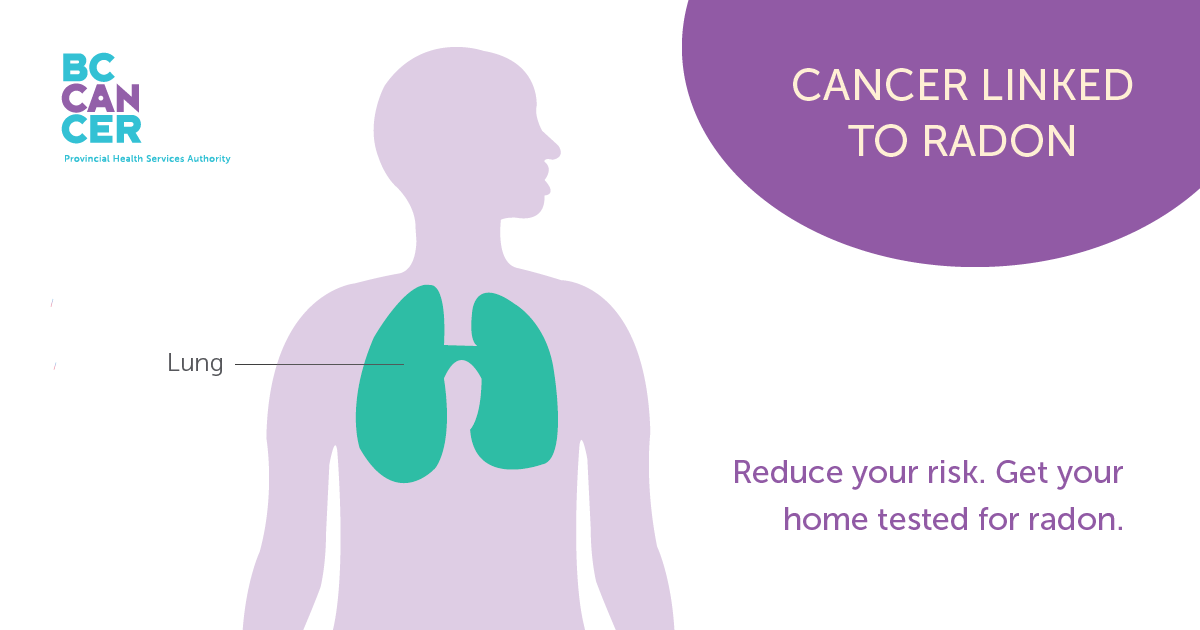About 16 per cent of all lung cancer deaths in Canada can be traced back to radon.
Radon is a radioactive gas that occurs naturally across Canada and B.C. when uranium in rock and soil breaks down. You can’t see, taste or smell it. The only way to know if high levels of radon are present is through testing.
Radon is not a health risk outdoors since the air dilutes the gas to low concentrations. Indoors, however, radon gas can become trapped and build up to higher levels, which, if exposed for a long time, can cause lung cancer.
Radon can enter homes and other buildings through:
- Cracks in floors, walls, or a building's foundation
- Openings for drains, utility systems and other openings in the foundation
- Unfinished floors, wall joints, or other openings in homes
- Being dissolved in water sources
Any home, school, office or other building can have high levels of radon, including new and old buildings. Radon levels can be affected by many things. For example:
- By what makes up the soil under and around your home.
- Basements usually have higher levels of radon since they are often below ground and don't have good air flow.
- Homes that are well insulated, tightly sealed, and/or built on soil rich in uranium, thorium and radium may have high radon levels (especially newer homes!).
- Rain, snow and barometric pressure can cause radon levels to change from month to month or day to day.
Radon is the leading environmental cause of lung cancer in non-smokers and the second-leading cause of lung cancer in smokers. According to Health Canada, radon gas exposure is linked to an estimated 16 per cent of all lung cancer deaths in Canada.

There is some, but not sufficient, evidence that radon exposure may be linked to other types of cancers, such as leukemia in adults and children.
If you smoke or used to smoke and you also live in a home with high radon levels, this can put you at even higher risk. For example, a non-smoker exposed to elevated levels of radon over time has a 1 in 20 chance of developing lung cancer, whereas a smoker exposed to the same radon level has a 1 in 3 chance of developing lung cancer.
When radon gas enters the air, it breaks down or decays into tiny radioactive particles that can get trapped in your lungs when you breathe. As these particles break down further, they release small bursts of energy into the soft tissue of your lungs, damaging the cells. This damage, much like the damage caused by smoking, can increase the risk of lung cancer.
The health risks from radon exposure are long-term and depend mostly on:
- How much radon is in your home or building;
- The amount of time you are exposed to radon; and,
- Your smoking habits or exposure to second-hand smoke.
- More than 3,300 Canadians die each year due to radon gas exposure.
- Radon is the leading cause of lung cancer in non-smokers.
- If you are also a smoker, your lung cancer risk is even higher when you are also around radon.
- Radon can be found in all buildings—both old and new alike. Its age or location can’t predict the level of radon. The only way to know the radon level in your home or other building is to test!
- We could prevent around 2,322 lung cancer cases by 2042 if all Canadians reduced high levels of radon in their homes.
